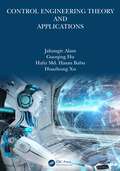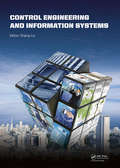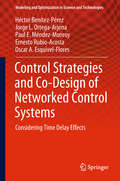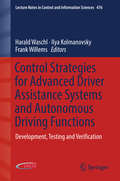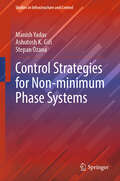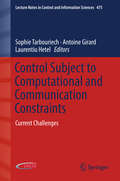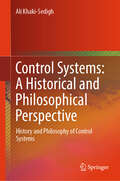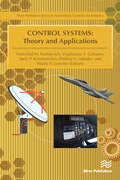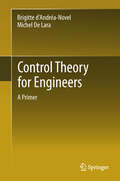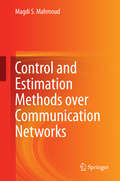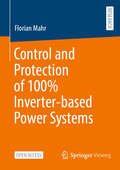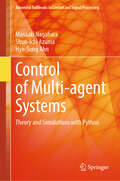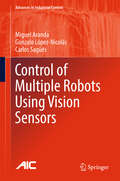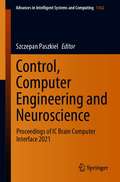- Table View
- List View
Control Charts and Machine Learning for Anomaly Detection in Manufacturing (Springer Series in Reliability Engineering)
by Kim Phuc TranThis book introduces the latest research on advanced control charts and new machine learning approaches to detect abnormalities in the smart manufacturing process. By approaching anomaly detection using both statistics and machine learning, the book promotes interdisciplinary cooperation between the research communities, to jointly develop new anomaly detection approaches that are more suitable for the 4.0 Industrial Revolution. The book provides ready-to-use algorithms and parameter sheets, enabling readers to design advanced control charts and machine learning-based approaches for anomaly detection in manufacturing. Case studies are introduced in each chapter to help practitioners easily apply these tools to real-world manufacturing processes. The book is of interest to researchers, industrial experts, and postgraduate students in the fields of industrial engineering, automation, statistical learning, and manufacturing industries.
Control Design and Analysis for Underactuated Robotic Systems
by Xin Xin Yannian LiuThe last two decades have witnessed considerable progress in the study of underactuated robotic systems (URSs). Control Design and Analysis for Underactuated Robotic Systems presents a unified treatment of control design and analysis for a class of URSs, which include systems with multiple-degree-of-freedom and/or with underactuation degree two. It presents novel notions, features, design techniques and strictly global motion analysis results for these systems. These new materials are shown to be vital in studying the control design and stability analysis of URSs. Control Design and Analysis for Underactuated Robotic Systems includes the modelling, control design and analysis presented in a systematic way particularly for the following examples: l directly and remotely driven Acrobots l Pendubot l rotational pendulum l counter-weighted Acrobot 2-link underactuated robot with flexible elbow joint l variable-length pendulum l 3-link gymnastic robot with passive first joint l n-link planar robot with passive first joint l n-link planar robot with passive single joint double, or two parallel pendulums on a cart l 3-link planar robots with underactuation degree two 2-link free flying robot The theoretical developments are validated by experimental results for the remotely driven Acrobot and the rotational pendulum. Control Design and Analysis for Underactuated Robotic Systems is intended for advanced undergraduate and graduate students and researchers in the area of control systems, mechanical and robotics systems, nonlinear systems and oscillation. This text will not only enable the reader to gain a better understanding of the power and fundamental limitations of linear and nonlinear control theory for the control design and analysis for these URSs, but also inspire the reader to address the challenges of more complex URSs.
Control Design of Multiagent Discrete-Time Systems (Studies in Systems, Decision and Control #387)
by MagdiSadek Mahmoud Bilal J. KarakiThis book describes an effective approach to the cooperative and coordinated control of multivehicle systems. This rigorous analytic approach guarantees the stability of coordinated and cooperating vehicles using distributed protocols and uses low-energy, event-triggered mechanisms for networked vehicle control. The text covers: design of a cooperative protocol to achieve consensus for multivehicle systems, allowing cooperation that is resistant to the effects of packet loss and/or adversarial attack; analysis and synthesis of an event-triggering mechanism for cooperative multivehicle systems over uncertain networks; and the problem of distributed leader-following consensus and methods for compelling multivehicle systems to reach consensus. Throughout the book, cooperation problems are transformed into stability problems. Lyapunov theory is used to guarantee cooperation among agents. The distributed approach is applied to triggering mechanisms, the cooperation process, and the impact of cyber-attacks. Discrete-time analysis shows how the event-based structure can be designed to match the performance of continuous-time counterparts. The book details applications and computer simulation with several practical examples. This book is of interest to a wide audience from the graduate student, through the academic researcher to the industrial practitioner, all of them sharing a common interest in the stability and security of multiagent systems.
Control Engineering Theory and Applications
by Hafiz Md. Babu Jahangir Alam Guoqing Hu Huazhong XuThe book provides general knowledge of automatic control engineering and its applications. Providing an overview of control theory and systems, the chapters introduce transfer functions, modeling of control systems, automatic control systems, block diagrams, and signal flow graphs. While control system analysis and design are accompanied by root-locus methods and frequency response analyses, distributed control systems, nonlinarity in control systems including Z-transformation are also presented. With straightforward demonstrations, examples, and multiple-choice questions, this book can be used as a reference textbook for electrical and electronics engineering, computer control engineering, automation engineering, mechatronics engineering, mechanics, robotics, AI control systems, hydraulics, process engineering, safety control engineering, aeronautical and aerospace engineering, auto-pilot system, decision-making system, and stock exchange, and will be suitable for majors, non-majors, and experts in the field of science and technology.
Control Engineering and Information Systems: Proceedings of the 2014 International Conference on Control Engineering and Information Systems (ICCEIS 2014, Yueyang, Hunan, China, 20-22 June 2014).
by Zhijing LiuControl Engineering and Information Systems contains the papers presented at the 2014 International Conference on Control Engineering and Information Systems (ICCEIS 2014, Yueyang, Hunan, China, 20-22 June 2014). All major aspects of the theory and applications of control engineering and information systems are addressed, including: � Intelligent s
Control Engineering in Mechatronics (Emerging Trends in Mechatronics)
by Aydin AziziThis book focusses on Industry 4.0 which is one of the most challenging trends for all categories of manufacturing enterprises. In this book, variety of mechatronic solutions are discussed to develop a manufacturing control system for small and medium-sized enterprises as they impose to improve their capabilities by integration into Industry 4.0 standards.
Control Engineering: From The Basics To The Applications (Advanced Textbooks in Control and Signal Processing)
by Ruth Bars László Keviczky Jenő Hetthéssy Csilla BányászThis book offers fundamental information on the analysis and synthesis of continuous and sampled data control systems. It includes all the required preliminary materials (from mathematics, signals and systems) that are needed in order to understand control theory, so readers do not have to turn to other textbooks. Sampled data systems have recently gained increasing importance, as they provide the basis for the analysis and design of computer-controlled systems. Though the book mainly focuses on linear systems, input/output approaches and state space descriptions are also provided. Control structures such as feedback, feed forward, internal model control, state feedback control, and the Youla parameterization approach are discussed, while a closing section outlines advanced areas of control theory. Though the book also contains selected examples, a related exercise book provides Matlab/Simulink exercises for all topics discussed in the textbook, helping readers to understand the theory and apply it in order to solve control problems. Thanks to this combination, readers will gain a basic grasp of systems and control, and be able to analyze and design continuous and discrete control systems.
Control Freak: My Epic Adventure Making Video Games
by Cliff BleszinskiThe designer of Unreal and Gears of War offers an eye-opening personal account of the video game industry as it grew from niche hobby to hundred-billion-dollar enterprise.Video games are dominating the planet. In 2020, they brought in $180 billion dollars globally—nearly $34 billion in the United States alone. So who are the brilliant designers who create these stunning virtual worlds? Cliff Bleszinski—or CliffyB as he is known to gamers—is one of the few who&’ve reached mythical, rock star status. In Control Freak, he gives an unvarnished, all-access tour of the business. Toiling away in his bedroom, Bleszinski created and shipped his first game before graduating high school, and at just seventeen joined a fledgling company called Epic Games. He describes the grueling hours, obscene amounts of Mountain Dew and obsessive focus necessary to achieve his singular creative visions. He details Epic&’s rise to industry leader, thanks largely to his work on bestselling franchises Unreal and Gears of War (and, later, his input on a little game called Fortnite), as well as his own awkward ascent from shy, acne-riddled introvert to sports car-driving celebrity rubbing shoulders with Bill Gates. As he writes, &“No one is weirder than a nerd with money.&” While the book is laced with such self-deprecating humor, Bleszinski also bluntly addresses the challenges that have long-faced the gaming community, including sexism and a lack of representation among both designers and the characters they create. Control Freak is a hilarious, thoughtful, and inspiring memoir. Even if you don&’t play games, you&’ll walk away from this book recognizing them as a true art form and appreciating the genius of their creators.
Control Language Programming For IBM I
by Jim Buck Bryan Meyers Dan RiehlCovering the basics of Control Language (CL) programming as well as the latest CL features—including new structured-programming capabilities, file-processing enhancements, and the Integrated Language Environment—this resource is geared towards students learning CL. The book guides readers towards a professional grasp of CL techniques, introducing complex processes and concepts through review questions, hands-on exercises, and programming assignments that reinforce each chapter’s contents. In addition to 25 chapters that cover CL from start to finish, a comprehensive appendix with condensed references to the most commonly used CL commands is also included along with two additional appendixes that cover the essentials of programming tools and debugging.
Control Strategies and Co-Design of Networked Control Systems: Considering Time Delay Effects (Modeling and Optimization in Science and Technologies #13)
by Héctor Benítez-Pérez Jorge L. Ortega-Arjona Paul E. Méndez-Monroy Ernesto Rubio-Acosta Oscar A. Esquivel-FloresThis book presents Networked Control System (NCS) as a particular kind of a real-time distributed system (RTDS), composed of a set of nodes, interconnected by a network, and able to develop a complete control process. It describes important parts of the control process such as sensor and actuator activities, which rely on a real-time operating system, and a real-time communication network. As the use of common bus network architecture introduces different forms of uncertainties between sensors, actuators, and controllers, several approaches such as reconfigurable systems have been developed to tackle this problem. Moreover, modeling NCS is a challenging procedure, since there are several non-linear situations, like local saturations, uncertain time delays, dead-zones, or local situations, it is necessary to deal with. The book describes a novel strategy for modelling and control based on a fuzzy control approach and codesign strategies.
Control Strategies for Advanced Driver Assistance Systems and Autonomous Driving Functions: Development, Testing and Verification (Lecture Notes in Control and Information Sciences #476)
by Harald Waschl Ilya Kolmanovsky Frank WillemsThis book describes different methods that are relevant to the development and testing of control algorithms for advanced driver assistance systems (ADAS) and automated driving functions (ADF). These control algorithms need to respond safely, reliably and optimally in varying operating conditions. Also, vehicles have to comply with safety and emission legislation. The text describes how such control algorithms can be developed, tested and verified for use in real-world driving situations. Owing to the complex interaction of vehicles with the environment and different traffic participants, an almost infinite number of possible scenarios and situations that need to be considered may exist. The book explains new methods to address this complexity, with reference to human interaction modelling, various theoretical approaches to the definition of real-world scenarios, and with practically-oriented examples and contributions, to ensure efficient development and testing of ADAS and ADF. Control Strategies for Advanced Driver Assistance Systems and Autonomous Driving Functions is a collection of articles by international experts in the field representing theoretical and application-based points of view. As such, the methods and examples demonstrated in the book will be a valuable source of information for academic and industrial researchers, as well as for automotive companies and suppliers.
Control Strategies for Non-minimum Phase Systems (Studies in Infrastructure and Control)
by Ashutosh K. Giri Stepan Ozana Manish YadavThis book provides overview of numerous control schemes for non-minimum phase and dead-time systems. The inverse response arises from the conflict of two first-order systems with opposite effects. This feature of the system is known as non-minim phase (NMP) process. The opposite response initiates from odd multiplicity of NMP open-loop zeros. As a result, the controller shows a limited gain margin and bandwidth, implying a robustness restriction. If the user tries to increase the gain, system sometimes gets unstable. Thus, the fundamental notion of providing a suitable balance control theory can potentially improve the performance of those processes. This book is useful to researchers working in the field of control system. The book provides comprehensive philosophy of different control schemes used for the non-minimum phase zeros and dead-time systems. The researcher working on non-minimum phase zeros can find innovative algorithms and novel schemes. Further, they can design innovative control schemes by referring to the content of chapters and specifically tuning after encountering NMP zeros and delay terms.
Control Subject to Computational and Communication Constraints: Current Challenges (Lecture Notes in Control and Information Sciences #475)
by Sophie Tarbouriech Laurentiu Hetel Antoine GirardThis book provides a broad overview of the current problems, challenges and solutions in the field of control theory, communication theory and computational resources management. Recent results on dynamical systems, which open new opportunities for research and challenges to be addressed in the future, are proposed in the context of computational and communication constraints. In order to take into the account complex phenomena, such as nonlinearities, time-varying parameters and limited availability of information, the book proposes new approaches for open problems with both theoretical and practical significance. The contributors’ research is centred on robust stability and performance of control loops that are subject to computational and communication constraints. A particular focus is placed on the presence of constraints in communication and computation, which is a critical issue in networked control systems and cyber-physical systems. The contributions, which rely on the development of novel paradigms are provided are by leading experts in the field from all over the world, thus providing readers with the most accurate solutions for the constraints. Control subject to Computational and Communication Constraints highlights many problems encountered by control researchers, while also informing graduate students of the many interesting ideas at the frontier between control theory, information theory and computational theory. The book is also a useful point of reference for engineers and practitioners, and the survey chapters will assist instructors in lecture preparation.
Control Systems Benchmarks (Advances in Industrial Control)
by José M. Maestre Carlos Ocampo-MartinezControl Systems Benchmarks helps control engineers, researchers, and students to evaluate and compare control system performance across a range of critical applications by offering a collection of real-world benchmarks. The book brings together challenges from diverse fields like power grids, robotics, automotive systems, and industrial processes, giving readers practical tools to test their control methods in realistic settings. Organized into two blocks, the book first tackles process control, covering dynamic and large-scale problems such as load-frequency control in power grids and wastewater-treatment-plant automation. The second block explores robotics and vehicles, focusing on areas like fault-tolerant control of quadrotors and lateral stability in electric vehicles. Each benchmark presents complex engineering challenges, allowing readers to experiment with various control approaches. This book is set apart by the consistent structure of its chapters, which enables readers to adapt benchmarks for their own systems easily. Each chapter includes: a brief overview of the benchmark, highlighting its significance and technical hurdles; a detailed problem description, including engineering goals and constraints; experimental setup, performance metrics, and data collection methods; downloadable materials and instructions for running simulations or accessing physical platforms; and a discussion of existing solutions, case studies, and open challenges to inspire further research. Whether you're a practitioner, an academic researcher, or a student eager to deepen your understanding of control systems, Control Systems Benchmarks offers practical insights and valuable resources to advance your work.
Control Systems: History and philosophy of control systems
by Ali Khaki-SedighThis book offers an exploration of the historical and philosophical aspects of the field of control systems engineering. By examining the historical and philosophical underpinnings of control systems, this book provides a holistic understanding of the challenges faced by control engineers and the need for a multidisciplinary approach. Written for engineers, scientists, and students, this book delves into the evolution of control systems theories from ancient times to the present day, highlighting the key contributions of influential thinkers and innovators. The book also explores how philosophical concepts, such as induction, falsification, and process philosophy, have shaped our understanding of control systems. The book's unique approach combines historical narratives with philosophical perspectives to provide a deeper understanding of the field. By examining the historical development of control systems, you will gain insight into the motivations and technological constraints that have influenced the evolution of control systems analysis and design methodologies. From the early applications of automation to modern and postmodern control systems, which rely on sophisticated algorithms and artificial intelligence, this book provides a comprehensive understanding of the field's progress. The book concludes by examining the future of control systems through the perspectives of leading control scientists and engineers. This comprehensive approach will equip the reader with a deeper understanding of the field to tackle complex problems in control systems analysis and design.
Control Systems: Theory and Applications (Studies In Systems, Decision And Control Ser. #203)
by Yuriy P. Kondratenko Vyacheslav F. Gubarev Vsevolod M. Kuntsevich Dmitriy V. Lebedev Vitaliy P. LysenkoIn recent years, a considerable amount of effort has been devoted, both in industry and academia, towards the development of advanced methods of control theory with focus on its practical implementation in various fields of human activity such as space control, robotics, control applications in marine systems, control processes in agriculture and food production.Control Systems: Theory and Applications consists of selected best papers which were presented at XXIV International conference on automatic control “Automatics 2017” (September 13-15, 2017, Kyiv, Ukraine) organized by Ukrainian Association on Automatic Control (National member organization of IFAC – International Federation on Automatic Control) and National University of Life and Environmental Sciences of Ukraine. More than 120 presentations where discussed at the conference, with participation of the scientists from the numerous countries. The book is divided into two main parts, a first on Theory of Automatic Control (5 chapters) and the second on Control Systems Applications (8 chapters). The selected chapters provide an overview of challenges in the area of control systems design, modeling, engineering and implementation and the approaches and techniques that relevant research groups within this area are employing to try to resolve these.This book on advanced methods of control theory and successful cases in the practical implementation is ideal for personnel in modern technological processes automation and SCADA systems, robotics, space and marine industries as well as academic staff and master/research students in computerized control systems, automatized and computer-integrated systems, electrical and mechanical engineering.
Control Theory for Engineers: A Primer (Environmental Science And Engineering / Environmental Engineering Ser.)
by Brigitte D'Andréa-Novel Michel De LaraControl Theory is at the heart of information and communication technologies of complex systems. It can contribute to meeting the energy and environmental challenges we are facing. The textbook is organized in the way an engineer classically proceeds to solve a control problem, that is, elaboration of a mathematical model capturing the process behavior, analysis of this model and design of a control to achieve the desired objectives. It is divided into three Parts. The first part of the text addresses modeling aspects through state space and input-output representations. The notion of the internal state of a system (for example mechanical, thermal or electrical), as well as its description using a finite number of variables, is also emphasized. The second part is devoted to the stability analysis of an equilibrium point. The authors present classical tools for stability analysis, such as linearization techniques and Lyapunov functions. Central to Control Theory are the notions of feedback and of closed-loop, and the third part of the textbook describes the linear control synthesis in a continuous and discrete-time framework and also in a probabilistic context. Quadratic optimization and Kalman filtering are presented, as well as the polynomial representation, a convenient approach to reject perturbations on the system without making the control law more complex. Throughout the text, different examples are developed, both in the chapters and in the exercises.
Control and Estimation Methods over Communication Networks
by Magdi S. MahmoudThis book provides a rigorous framework in which to study problems in the analysis, stability and design of networked control systems. Four dominant sources of difficulty are considered: packet dropouts, communication bandwidth constraints, parametric uncertainty, and time delays. Past methods and results are reviewed from a contemporary perspective, present trends are examined, and future possibilities proposed. Emphasis is placed on robust and reliable design methods. New control strategies for improving the efficiency of sensor data processing and reducing associated time delay are presented. The coverage provided features: · an overall assessment of recent and current fault-tolerant control algorithms; · treatment of several issues arising at the junction of control and communications; · key concepts followed by their proofs and efficient computational methods for their implementation; and · simulation examples (including TrueTime simulations) to provide hands-on experience. In addition to the theoretical coverage, the author describes a number of applications that demonstrate the real-world relevance of this material, and these include: · a servo system; · a triple inverted pendulum; · power system control; · wireless control of a cart with inverted pendulum and wireless servo application with emphasis on controller area networks; and · switched ethernet and wireless area networks. Researchers and graduate students working in networked and distributed control will find this text a useful guide in avoiding and ameliorating common and serious problems with these systems. The increasing prevalence of networks in many fields of engineering will make Control and Estimation Methods over Communication Networks of interest to practitioners with backgrounds in communications, process engineering, robotics, power, automotive and other areas.
Control and Protection of 100% Inverter-based Power Systems
by Florian MahrIn this Open-Access book, voltage source converters (VSCs) as key components of sustainable energy systems based on wind power plants, photovoltaic power plants, battery energy systems, electric vehicles and heat pumps are investigated. In the future, 100% inverter-based power systems (IBPS) will arise. Protective systems against grid faults are a substantial part of electrical grids. They prevent danger to living beings and damage to technical equipment caused by grid faults. The control algorithms of VSCs and protection algorithms must collaborate in future grids. Otherwise, the reliability of energy supply is at risk. Today, control and protection are often regarded independently of each other. In this book, they are investigated mutually. The resilience of the system against grid faults is increased by using flexibility options of VSCs. A universal protection algorithm, which does not restrict these flexibility options, is developed. In this book, post-fault characteristics of VSCs, neutral point treatment and resonant grounding via VSCs and a model-based protection algorithm are presented. The sustainable and reliable energy supply is an essential cornerstone of human societies. This book is pointing out a holistic approach for the control and protection of 100% IBPS contributes along this way.
Control of Variable-Geometry Vehicle Suspensions: Design and Analysis (Advances in Industrial Control)
by Péter Gáspár Balázs NémethThis book provides a thorough and fresh treatment of the control of innovative variable-geometry vehicle suspension systems. A deep survey on the topic, which covers the varying types of existing variable-geometry suspension solutions, introduces the study. The book discusses three important aspects of the subject:• robust control design;• nonlinear system analysis; and• integration of learning and control methods.The importance of variable-geometry suspensions and the effectiveness of design methods implemented in the autonomous functionalities of electric vehicles—functionalities like independent steering and torque vectoring—are illustrated. The authors detail the theoretical background of modeling, control design, and analysis for each functionality. The theoretical results achieved through simulation examples and hardware-in-the-loop scenarios are confirmed. The book highlights emerging ideas of applying machine-learning-based methods in the control system with guarantees on safety performance. The authors propose novel control methods, based on the theory of robust linear parameter-varying systems, with examples for various suspension systems.Academic researchers interested in automotive systems and their counterparts involved in industrial research and development will find much to interest them in the eleven chapters of Control of Variable-Geometry Vehicle Suspensions.
Control of Marine Vehicles (Springer Series on Naval Architecture, Marine Engineering, Shipbuilding and Shipping #9)
by Karl Dietrich von EllenriederThis textbook offers a comprehensive introduction to the control of marine vehicles, from fundamental to advanced concepts, including robust control techniques for handling model uncertainty, environmental disturbances, and actuator limitations. Starting with an introductory chapter that extensively reviews automatic control and dynamic modeling techniques for ocean vehicles, the first part of the book presents in-depth information on the analysis and control of linear time invariant systems. The concepts discussed are developed progressively, providing a basis for understanding more complex techniques and stimulating readers’ intuition. In addition, selected examples illustrating the main concepts, the corresponding MATLAB® code, and problems are included in each chapter. In turn, the second part of the book offers comprehensive coverage on the stability and control of nonlinear systems. Following the same intuitive approach, it guides readers from the fundamentals to more advanced techniques, which culminate in integrator backstepping, adaptive and sliding mode control. Leveraging the author’s considerable teaching and research experience, the book offers a good balance of theory and stimulating questions. Not only does it provide a valuable resource for undergraduate and graduate students; it will also benefit practitioners who want to review the foundational concepts underpinning some of the latest advanced marine vehicle control techniques, for use in their own applications.
Control of Multi-agent Systems: Theory and Simulations with Python (Advanced Textbooks in Control and Signal Processing)
by Hyo-Sung Ahn Shun-Ichi Azuma Masaaki NagaharaThis textbook teaches control theory for multi-agent systems. Readers will learn the basics of linear algebra and graph theory, which are then developed to describe and solve multi-agent control problems. The authors address important and fundamental problems including: • consensus control; • coverage control; • formation control; • distributed optimization; and • the viral spreading phenomenon. Students' understanding of the core theory for multi-agent control is enhanced through worked examples and programs in the popular Python language. End-of-chapter exercises are provided to help assess learning progress. Instructors who adopt the book for their courses can download a solutions manual and the figures in the book for lecture slides. Additionally, the Python programs are available for download and can be used for experiments by students in advanced undergraduate or graduate courses based on this text. The broad spectrum of applications relevant to this material includes the Internet of Things, cyber-physical systems, robot swarms, communications networks, smart grids, and truck platooning. Additionally, in the spheres of social science and public health, it applies to opinion dynamics and the spreading of viruses in social networks. Students interested in learning about such applications, or in pursuing further research in multi-agent systems from a theoretical perspective, will find much to gain from Control of Multi-agent Systems. Instructors wishing to teach the subject will also find it beneficial.
Control of Multiple Robots Using Vision Sensors (Advances in Industrial Control)
by Carlos Sagüés Miguel Aranda Gonzalo López-NicolásThis monograph introduces novel methods for the control and navigation of mobile robots using multiple-1-d-view models obtained from omni-directional cameras. This approach overcomes field-of-view and robustness limitations, simultaneously enhancing accuracy and simplifying application on real platforms. The authors also address coordinated motion tasks for multiple robots, exploring different system architectures, particularly the use of multiple aerial cameras in driving robot formations on the ground. Again, this has benefits of simplicity, scalability and flexibility. Coverage includes details of: a method for visual robot homing based on a memory of omni-directional images; a novel vision-based pose stabilization methodology for non-holonomic ground robots based on sinusoidal-varying control inputs; an algorithm to recover a generic motion between two 1-d views and which does not require a third view; a novel multi-robot setup where multiple camera-carrying unmanned aerial vehicles are used to observe and control a formation of ground mobile robots; and three coordinate-free methods for decentralized mobile robot formation stabilization. The performance of the different methods is evaluated both in simulation and experimentally with real robotic platforms and vision sensors. Control of Multiple Robots Using Vision Sensors will serve both academic researchers studying visual control of single and multiple robots and robotics engineers seeking to design control systems based on visual sensors.
Control of Singular Fractional Order Systems: Stability, Stabilization and Admissibility (Studies in Systems, Decision and Control #292)
by Mohammed Chadli Saliha MarirThis book provides a comprehensive study of singular fractional-order systems, presenting a novel perspective on their analysis and control. Using the Linear Matrix Inequalities approach, it provides conditions for admissibility, robust admissibility, stabilization, and robust stabilization of fractional singular linear time-invariant systems. The methods discussed address key challenges in stability and robustness, and provide innovative solutions to open problems in fractional-order control theory. Aimed at control scientists, graduate students, and advanced undergraduates, this work bridges theoretical developments and practical applications, making it a valuable resource for understanding and advancing the field of fractional-order systems. It is particularly suitable for those seeking new directions in control systems research or who wish to apply fractional tools to dynamic systems modeling and control. With its unique focus and broad scope, this book serves as an indispensable reference for courses such as "Analysis and Control of Fractional-Order Systems" and "LMI-Based Control of Singular Fractional-Order Systems".
Control, Computer Engineering and Neuroscience: Proceedings of IC Brain Computer Interface 2021 (Advances in Intelligent Systems and Computing #1362)
by Szczepan PaszkielThis book presents the proceedings of the 4th International Scientific Conference IC BCI 2021 Opole, Poland. The event was held at Opole University of Technology in Poland on 21 September 2021. Since 2014, the conference has taken place every two years at the University’s Faculty of Electrical Engineering, Automatic Control and Informatics. The conference focused on the issues relating to new trends in modern brain–computer interfaces (BCI) and control engineering, including neurobiology–neurosurgery, cognitive science–bioethics, biophysics–biochemistry, modeling–neuroinformatics, BCI technology, biomedical engineering, control and robotics, computer engineering and neurorehabilitation–biofeedback.



